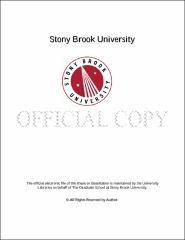| dc.identifier.uri | http://hdl.handle.net/11401/77089 | |
| dc.description.sponsorship | This work is sponsored by the Stony Brook University Graduate School in compliance with the requirements for completion of degree. | en_US |
| dc.format | Monograph | |
| dc.format.medium | Electronic Resource | en_US |
| dc.language.iso | en_US | |
| dc.publisher | The Graduate School, Stony Brook University: Stony Brook, NY. | |
| dc.type | Dissertation | |
| dcterms.abstract | Sulfur rich metal coordinated active sites is a prominent feature of many metalloenzymes (hydrogenase, nitrogenase, carbon monoxide dehydrogenase) involved in catalytically producing and/or absorbing helpful and/or toxic gases. As the mechanism of gas production and/or absorption heavily depends on the structural intricacies, biomimetic modelling of the active sites is of paramount importance to understand the structure-function relationship. It has been established that the small molecule models with steric bulk of the thiols at the ortho- position of derivatized benzenethiols can provide the stability. Millar and Koch were pioneers in introducing a series of ortho-steric benzene thiols and achieving stabilization of high oxidation state first row transition metal complexes. Fe<super>3+</super> & Co<super>3+</super> complexes and Fe<sub>4</sub>S<sub>4</sub> tertamer with 2,4,6-triisopropyl-benzenethiol are the highlights. Following the idea of increasing the steric bulk, this thesis will present a new compound - 2,4,6-tricyclohexylbenzenethiol, and attempted synthesis and characterization of monomeric and tetrameric metal complexes with it. Dithiols such as ethanedithiol (edt) and 1,2-benzenedithiol (bdt) have been extensively used for synthesizing models due to their simplicity in structure. While edt lacks the required steric bulk, bdt is a non-innocent ligand influencing electrochemical properties of the complexes. To combat these difficulties, a new class of dithiol was introduced by Michelle Millar and Stephen Koch - norbornanedithiol - a conformationally fixed alkane dithiol. Metal complexes with Fe<super>2+</super>, Co<super>2+</super>, Ni<super>2+</super> & Pt<super>2+</super> will be discussed. Hydrogen bonding of the solvent molecules to the thiolates and the implications of such observation will be presented. Fe-Ni hydrogenases are responsible for converting H<sub>2</sub> gas to H<super>+</super>. This class of enzyme contains a bimetallic active site. In our effort to mimic the structure, we have crystallographically characterized Fe-Ni bimetallic compounds with bridged thiolates and intermetallic distance of ~3Ã… as found in the wild type from Desulfovibrio gigas. An extensive IR study of the reaction and the compounds will be presented. | |
| dcterms.abstract | Sulfur rich metal coordinated active sites is a prominent feature of many metalloenzymes (hydrogenase, nitrogenase, carbon monoxide dehydrogenase) involved in catalytically producing and/or absorbing helpful and/or toxic gases. As the mechanism of gas production and/or absorption heavily depends on the structural intricacies, biomimetic modelling of the active sites is of paramount importance to understand the structure-function relationship. It has been established that the small molecule models with steric bulk of the thiols at the ortho- position of derivatized benzenethiols can provide the stability. Millar and Koch were pioneers in introducing a series of ortho-steric benzene thiols and achieving stabilization of high oxidation state first row transition metal complexes. Fe<super>3+</super> & Co<super>3+</super> complexes and Fe<sub>4</sub>S<sub>4</sub> tertamer with 2,4,6-triisopropyl-benzenethiol are the highlights. Following the idea of increasing the steric bulk, this thesis will present a new compound - 2,4,6-tricyclohexylbenzenethiol, and attempted synthesis and characterization of monomeric and tetrameric metal complexes with it. Dithiols such as ethanedithiol (edt) and 1,2-benzenedithiol (bdt) have been extensively used for synthesizing models due to their simplicity in structure. While edt lacks the required steric bulk, bdt is a non-innocent ligand influencing electrochemical properties of the complexes. To combat these difficulties, a new class of dithiol was introduced by Michelle Millar and Stephen Koch - norbornanedithiol - a conformationally fixed alkane dithiol. Metal complexes with Fe<super>2+</super>, Co<super>2+</super>, Ni<super>2+</super> & Pt<super>2+</super> will be discussed. Hydrogen bonding of the solvent molecules to the thiolates and the implications of such observation will be presented. Fe-Ni hydrogenases are responsible for converting H<sub>2</sub> gas to H<super>+</super>. This class of enzyme contains a bimetallic active site. In our effort to mimic the structure, we have crystallographically characterized Fe-Ni bimetallic compounds with bridged thiolates and intermetallic distance of ~3Å as found in the wild type from Desulfovibrio gigas. An extensive IR study of the reaction and the compounds will be presented. | |
| dcterms.available | 2017-09-20T16:51:56Z | |
| dcterms.contributor | Koch, Stephen A | en_US |
| dcterms.contributor | Lauher, Joseph | en_US |
| dcterms.contributor | Mayr, Andreas | en_US |
| dcterms.contributor | Jiang, Jianfeng. | en_US |
| dcterms.creator | Bhattacharya, Soumya | |
| dcterms.dateAccepted | 2017-09-20T16:51:56Z | |
| dcterms.dateSubmitted | 2017-09-20T16:51:56Z | |
| dcterms.description | Department of Chemistry. | en_US |
| dcterms.extent | 152 pg. | en_US |
| dcterms.format | Monograph | |
| dcterms.format | Application/PDF | en_US |
| dcterms.identifier | http://hdl.handle.net/11401/77089 | |
| dcterms.issued | 2014-12-01 | |
| dcterms.language | en_US | |
| dcterms.provenance | Made available in DSpace on 2017-09-20T16:51:56Z (GMT). No. of bitstreams: 1
Bhattacharya_grad.sunysb_0771E_11966.pdf: 4164843 bytes, checksum: e016776a42703f0d72a4c6f063807808 (MD5)
Previous issue date: 1 | en |
| dcterms.publisher | The Graduate School, Stony Brook University: Stony Brook, NY. | |
| dcterms.subject | Chemistry | |
| dcterms.subject | biomimetic modelling, metalloenzyme | |
| dcterms.title | Metal Complexes for Structural Modeling of Active Sites of Metalloenzymes Relevant to Gas Catalysis | |
| dcterms.type | Dissertation | |

